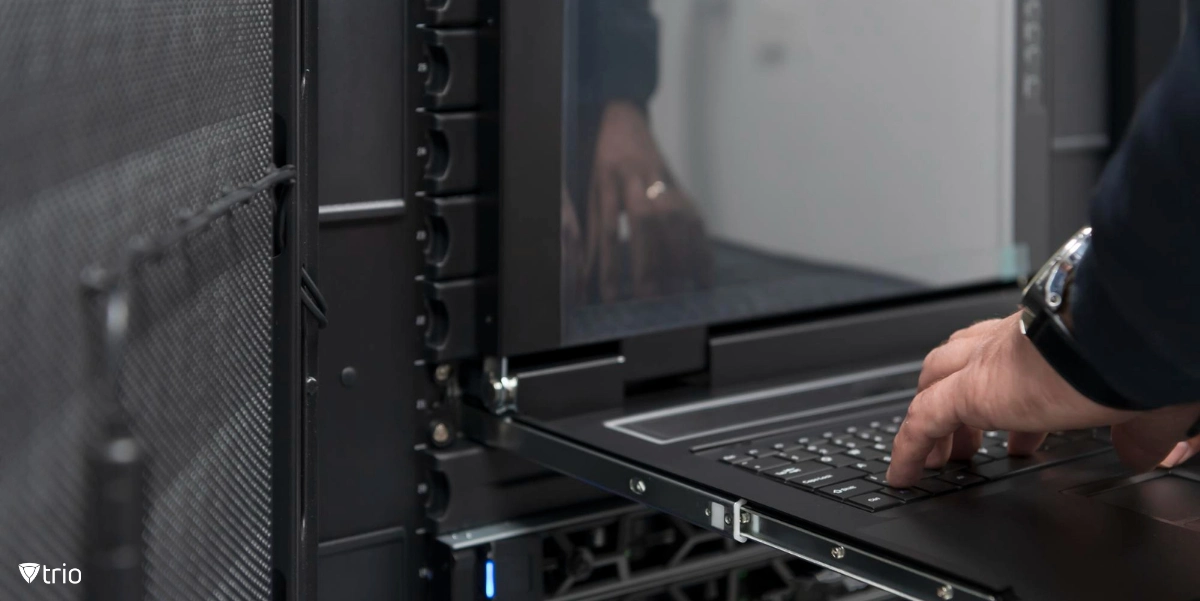Navigating the complexities of Dynamic Host Configuration Protocol (DHCP) server management is crucial for maintaining a robust, efficient, and secure network. Implementing DHCP server best practices is key to optimizing network performance.
This blog will guide you through the fundamental steps and considerations for configuring a DHCP server, effective DHCP management, choosing the best server settings, maintaining your DHCP server effectively, and configuring optimal lease times for your network environment.
Configuring DHCP Server
A DHCP server, standing for Dynamic Host Configuration Protocol, is instrumental in effective DHCP management, automatically assigning IP addresses and essential network configuration details to devices on a network. This automatic provisioning streamlines network management, eliminating the need for manual IP address assignment, which can be time-consuming and prone to errors.
In configuring DHCP servers, it’s essential to understand the broader context of server management, which includes keeping software up-to-date and secure, or understanding how protocols like LDAP work. Configuring a DHCP server is essential for efficient network management, ensuring that all devices connect smoothly and securely. Here’s how to do it effectively:
- Define IP Address Pools: Start by establishing pools of IP addresses that the DHCP server can allocate to devices. These pools should align with your network layout and the number of devices you expect to connect. Considering future growth while setting these pools helps avoid running out of addresses as new devices join the network.
- Set Appropriate Lease Times: Decide on the lease duration for IP addresses based on your network’s specific requirements. Shorter lease times can be beneficial for networks with a high turnover of devices, ensuring IPs are freed up quickly. However, longer leases may reduce DHCP traffic and are suitable for more stable environments.
- Configure DHCP Options: Essential network settings like default gateways, DNS servers, and subnet masks should be specified within your DHCP configurations. These options guide connected devices on how to communicate within the network and access the internet, ensuring a seamless online experience.
- Implement DHCP Reservations: For devices that require consistent IP addresses, such as servers or network printers, set up DHCP reservations. This approach assigns a fixed IP address to a device based on its MAC address, combining the convenience of DHCP with the stability of static IP assignments.
- Secure Your DHCP Server: Protecting your DHCP server is crucial for preventing unauthorized access and mitigating DHCP starvation attacks, where an attacker depletes the pool of available IP addresses. Implementing security measures such as MAC address filtering, turning on DHCP snooping on your switches, and regularly updating the DHCP server software helps maintain a secure and reliable network.
By following these steps, you can ensure that your DHCP server is well-configured, providing reliable IP address allocation while maintaining network security and efficiency.

DHCP IPv4 vs IPv6
When it comes to managing and configuring DHCP servers, understanding the differences between DHCP for IPv4 and IPv6 is crucial for modern network administration. While both versions aim to simplify IP address allocation, their operational nuances highlight the evolution of Internet technology and the need for advanced network strategies.
IPv4, established as the backbone of the internet for decades, utilizes DHCP to dynamically assign the limited 32-bit IP addresses available. This mechanism has been essential in efficiently managing IP resources within networks, especially with the DHCP server lease time best practices, resulting in optimal address utilization. However, the exponential growth of internet-connected devices has stretched the IPv4 scheme to its limits, leading to a pressing need for more addresses.
Enter IPv6, with its vast 128-bit address space, promising virtually unlimited IP addresses to accommodate the burgeoning Internet of Things (IoT) landscape. DHCPv6, the counterpart to DHCP for IPv4, addresses the scalability issue and introduces several improvements and features designed to enhance network management and security.
When comparing IPv4 vs. IPv6 allocation strategies, note that IPv6 allocation strategies often leverage stateless address autoconfiguration (SLAAC) for device self-configuration, alongside or instead of traditional DHCP. However, DHCPv6 isn’t just a direct translation of DHCPv4 into a larger address space; it’s an opportunity to implement more sophisticated network policies, including privileged access management. Effective Allocation Strategies consider the unique benefits and challenges of each protocol, ensuring a balanced and forward-looking network infrastructure capable of supporting an ever-more connected world.

DHCP Server Maintenance Essentials
Maintaining your DHCP server is crucial for ensuring network stability and reliability. Regular maintenance tasks include monitoring the server’s performance, auditing the IP address allocations, and ensuring the DHCP server software is up to date with the latest security patches and updates. Moreover, implementing privileged access management would safeguard DHCP configurations, ensuring only authorized adjustments are made.
It’s also important to regularly review the DHCP server logs for any unusual activity or errors that could indicate potential issues. These logs can provide valuable insights into DHCP operations, helping to quickly identify and resolve any problems, such as IP address conflicts or unauthorized access attempts. Additionally, backing up your DHCP server configuration regularly can prevent data loss and facilitate quick recovery in case of hardware failure or other disasters. This backup should include not just the DHCP database but also the server’s configuration settings and any custom scripts or policies in use.
Furthermore, managing the scope of your DHCP server efficiently is vital. This involves adjusting the lease duration based on network needs to balance between minimizing unnecessary traffic and ensuring IP addresses are available for new devices. For networks with high turnover or a large number of transient devices, shorter lease times can help maintain a pool of available addresses. Conversely, for stable environments with devices that remain on the network long-term, longer lease times can reduce DHCP traffic and server load. Proactively managing these aspects of your DHCP server ensures it operates smoothly, supports network growth, and adapts to changing business requirements, keeping your network secure and efficiently managed.
Optimal Lease Time for DHCP Servers: Finding the Right Balance
DHCP server lease time best practice involves striking a balance between network flexibility and stability. The DHCP lease time is the duration for which an IP address is assigned to a device before it needs to be renewed or released. A shorter lease time can be advantageous for networks with a high degree of mobility or temporary devices, as it ensures that IP addresses are recycled more frequently, reducing the likelihood of IP address exhaustion. For instance, a guest Wi-Fi network might benefit from a lease time of just a few hours, ensuring that IP addresses are readily available for new connections.
Conversely, longer lease times can indeed have a positive impact on network traffic by reducing the frequency of IP address renewals. This is particularly advantageous in environments characterized by stable device configurations, such as office workstations. By extending the lease time to several days or even a week, organizations can effectively minimize the DHCP server’s workload and mitigate the risk of network interruptions resulting from frequent lease renewal processes.
However, it’s imperative to conduct a thorough assessment of your network’s specific needs and dynamics before determining the optimal DHCP lease time. Factors such as the number of devices, their mobility, and the overall network utilization must be carefully considered to ensure efficient and reliable network operations. Furthermore, adherence to industry best practices and recommended guidelines can serve as invaluable resources when devising an effective DHCP management strategy.
In addition to DHCP lease time optimization, organizations should also prioritize effective Windows Server user management as part of their broader network management initiatives. User accounts and access rights play a crucial role in ensuring data security, regulatory compliance, and overall network integrity. Implementing robust user management practices, such as role-based access control (RBAC), password policies, and account auditing mechanisms, can help organizations maintain a secure and well-organized Windows Server environment.
Furthermore, leveraging advanced features and tools available within Windows Server, such as Active Directory (AD) and Group Policy, can streamline user provisioning, authentication, and authorization processes while enhancing overall network efficiency and security. By employing a comprehensive approach to Windows Server user management alongside DHCP lease time optimization, organizations can effectively address key operational challenges and maintain a resilient and secure network infrastructure.

How Many DHCP Servers Should I Have?
How many DHCP servers you should have depends on various factors, including the size of your network, the number of clients, and your network’s redundancy and reliability requirements. Here’s a more detailed look at these considerations:
- Network Size and Client Volume: For small networks with a limited number of clients, a single DHCP server might be sufficient to manage IP address assignments efficiently. However, as your network grows and the number of client devices increases, relying on a single DHCP server can become a risk. If that server goes down, all new devices trying to connect to the network would be unable to obtain an IP address, causing connectivity issues.
- Redundancy and Reliability: To ensure network reliability, it’s advisable to have at least two DHCP servers. This setup provides redundancy, meaning if one server fails, the other can continue to serve client requests without interruption. Implementing DHCP failover or load balancing between these servers ensures that IP address allocation continues seamlessly, even in the event of a server failure.
- Network Segmentation: In large networks or organizations with multiple branches, it’s often practical to deploy DHCP servers strategically across different segments or locations. This approach can reduce latency for clients requesting IP addresses and minimize potential points of failure that could affect the entire network. Furthermore, implementing conditional access policies alongside DHCP servers provides an added layer of security, especially in complex network environments using network segmentation.
Conclusion
From setting optimal lease times to choosing the right server for your needs, adhering to DHCP server best practices plays a pivotal role in network management. As networks evolve and the transition towards IPv6 becomes more pronounced, staying informed and flexible in your DHCP management strategies ensures your network remains reliable, secure, and efficient. For those looking to dive deeper into DHCP configurations and optimizations, exploring detailed guides on DHCP management and IPv6 allocation strategies can provide valuable insights and practical tips for network administrators.
In the context of Bring Your Own Device (BYOD) policies, combining Mobile Device Management (MDM) with DHCP servers becomes very important. DHCP can work together with MDM to automatically set up network options for each device based on its own rules. This ensures that each device, whether it’s personally owned or company-issued, receives appropriate network configurations, aligning with the company’s security protocols.
Trio is a cutting-edge MDM solution that integrates with DHCP seamlessly, enhancing network configurations for both IPv4 and IPv6 environments. With Trio, streamline your device management and ensure every device complies with your network policies effortlessly. Try Trio’s free demo today and revolutionize your network management strategy.
Get Ahead of the Curve
Every organization today needs a solution to automate time-consuming tasks and strengthen security.
Without the right tools, manual processes drain resources and leave gaps in protection. Trio MDM is designed to solve this problem, automating key tasks, boosting security, and ensuring compliance with ease.
Don't let inefficiencies hold you back. Learn how Trio MDM can revolutionize your IT operations or request a free trial today!




